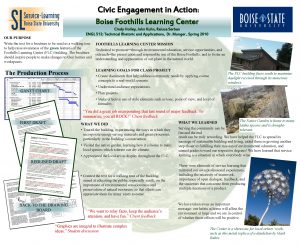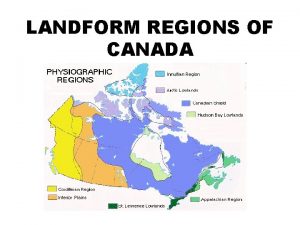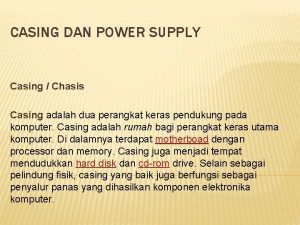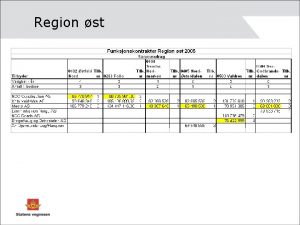Case Study Foothills Region Canada 2008 CASING DRILLINGTM









- Slides: 9

Case Study – Foothills Region, Canada 2008 CASING DRILLINGTM Plastering Success • 9 -5/8” casing x 12 -1/4” EZCase drilled from 850 M to 1, 250 M • CD effectively reduced lost circulation while drilling • NPT reduction > 50% Measured depth, meters 860 960 1060 1160 1260 0 2 4 6 8 10 Days from Drill-out of Previous Casing 12

2008 Results from Canadian Foothills: Measured depth, meters Circulation Improved while Drilling Ahead Partial Loss Stop drilling Drilling 100% 50% 0%

Artic Permafrost Application Mackenzie Delta –Canada Conventional Drilling Issues • Keeping Permafrost frozen is critical to wellbore stability. • Hydrates and borehole erosion. • Mud cooling is required. • Conventional drilling requires high flow rates for hole cleaning. • Lots of problems with high flow rate coolers. • Difficult to keep hole stabile while tripping to run casing. • Small pumps dictated by ice road limits. SPE paper 111806

Artic Permafrost Application Mackenzie Delta –Canada Casing Drilling Solution • Drilling with casing: • eliminated need to trip. • allowed good cleaning at low flow rates. • minimized pressure losses (heating). • implemented with small pumps • BHA: 17 -1/2 EZCase bit, stab, float collar, joint of casing, float collar, stab, 4 jts casing, stab, csg • Mud cooling. • KCl polymer mud (8 -10% KCl depresses freezing) • Spiral heat exchanger, ammonia refrigerant, glycol heat exchanger fluid • Spiral exchanger minimized plugging but gave adequate contact surface and time.

Conclusions/Observations • Minimized flat time. • No borehole stability issues. • Cooling system & CD prevented permafrost from degrading. • Extended casing setting depth well below base of permafrost. • Kept ROP below 15 m/hr to minimize need to stop drilling and circulate for hydraulic lift. • Walnut hull sweeps used to control balling. • EZCase drilled out with TCI bit.

CASING DRILLING® Project Summary Pan American ENERGY, Argentina Ø PAE received approval from government to extend its Cerro Dragon concession (4000 Km 2) to 2017. They will drill approximately 300 wells /year. Ø At least 10% of these well will benefit from Cw. D, due to problems associated to Water Injection/ depletion problems (High Losses). Ø Cw. D project initiated as Enhanced Productivity Project (rather than Drilling) Ø A typical well is cased with 9 5/8” @ 300 m & 5 ½” @ 2, 400 m. Ø Tesco® Project: Evaluate a 5 well Project with 5½” BRT® OBJECTIVE: To be able to drill the production hole with minimum NPT associated to losses, trips, allowing a positive impact on the productivity of the well

Pan American. CENERGY Project. C Grande Dragon Summary Conv. CD 1 CD 2 CD 3 Ø Ø Ø Conv. CD 4 CD 5 Successfully drilled both areas: Averaged 14 days/well. Reduce NPT related to loss circulation and highly damaged reservoirs. Reduced production hole from 13 to 11 days. Good quality wells: Better CBL’s and one well did not require fracturing. C Grande previously considered not accessible. Value: Less Completion Costs & possibly better productivity. CURRENT CUSTOMER STATUS: PAE Evaluating production results. PAE requesting fiscal leverage from government related to technology deployment, in order to start back in Jan 09

SUCCESS IN THE ARABIAN GULF What: Where: 2 nd OFFSHORE DIRECTIONAL CASING DRILLING™ from a SIDETRACK QATAR – MIDDLE EAST Challenge: • Lost 2 BHA’s drilling conventionally thru the unstable shale formation. Objective: • Drill a directional section through unstable shale formation with 9 5/8” casing. Results: • Used CDS™ to make up and run 9 5/8” casing, then drilled with the casing • CASING DRILLING™ successfully drilled the 12 ¼” hole section into the reservoir Job Details: • Casing Size: 9 -5/8 - 47 Lbs/ft, L 80, BTC c/w MLT™ Rings • CASING DRILLING™ footage drilled 1, 416 ft • Job Date: September, 2008

SUCCESS IN THE ARABIAN GULF Operations: • BHA: PDC Bit/Rotary Steerable/MWD/RR/UR/Motor/DLA • No issues tripping / drilling casing thru openhole sidetrack • Used 1 BHA to drill the entire hole section at 38 ft/hr • Successfully set / retrieved BHA using drill pipe (Level 3) • Built from 65° to 86. 4°, turning the azimuth from 272° to a 292° • Unstable shale, pack-off csg near TD in the top of the reservoir • BHA, tripped thru casing to surface, leaving shale behind casing Highlights: • No QHSE incident occurred during the Job • No rig modifications were required • Tesco’s CDE™ torque modeling proved reliable • No loss circulation, Torque and Drag trended well • Achieved desired directional trajectory • Provided cased wellbore into reservoir. RSS CD-BHA

















